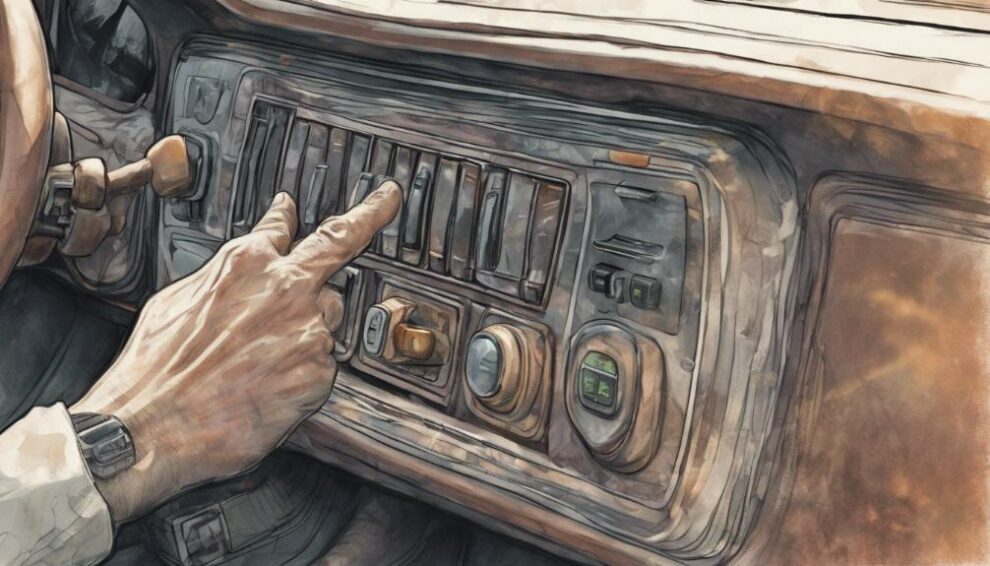When your power windows act up, understanding window switch function, diagnosis, and symptoms is key. The switch on the door panel controls window movement by sending signals to the motor.
Issues like unresponsive windows or one-way movement signal a problem. Diagnostic steps involve using a multimeter to test continuity and voltage.
Check for loose connections that might cause flickering or inconsistent operation. Sound checks may reveal underlying problems. For smooth window operation, grasp the connections between switch, current, and motor.
Master these steps to pinpoint and fix window switch glitches efficiently.
What You Need to Know
- Window switch controls power window motors.
- Unresponsive windows indicate switch issues.
- Test with multimeter for accurate diagnosis.
- Check power and ground connections for flow.
- Symptoms include inconsistent or one-way movement.
Window Switch Function Overview

The window switch serves as the primary mechanism for controlling power windows in your vehicle. Located on the door panel, these switches play an essential role in the power window system.
When you press the switch, it sends electrical signals to the window motor, prompting it to either raise or lower the window. Each window in your vehicle has its own switch, allowing for individual control.
It’s important to understand how these components work together to guarantee proper operation of your power windows.
Understanding Window Switch Diagnosis
To diagnose window switch issues effectively, begin by understanding the key functions of the switch and how they relate to power window operation. When dealing with window switch diagnosis, keep the following points in mind:
- Power Control: The window switch controls the flow of electrical current to the power window motors. Understanding how the switch regulates this power is essential for diagnosing issues accurately.
- Symptom Recognition: Common symptoms of faulty window switches include unresponsive windows or erratic movement. These symptoms can indicate underlying problems with the switch that need to be addressed promptly.
- Diagnostic Steps: Diagnosis involves checking for power and ground at the switch using a multimeter.
By following a structured diagnostic process, you can pinpoint the root cause of window switch malfunctions and proceed with effective repairs.
Understanding the interplay between the window switch, electrical current, and power window motors is critical for successful troubleshooting.
Recognizing Common Symptoms of Issues

How can you easily identify common symptoms of window switch issues?
When dealing with window switch problems, there are several key symptoms to look out for.
If your power window motor is unresponsive to the switch when trying to operate the window, it could indicate window switch issues.
Then, if the window moves in one direction but not the other, this may point to a faulty window switch.
Keep an eye out for flickering or inconsistent operation of the window when using the switch, as this could also signal underlying switch issues.
Another symptom to be aware of is a window that only works intermittently or requires multiple attempts to function properly, which may indicate a faulty switch.
In some cases, physical damage or a loose feel to the window switch could be signs of a need for replacement or repair.
Testing Electrical Components for Diagnosis
Testing the electrical components for diagnosing window switch issues involves using a multimeter to check continuity and voltage in the switch connections. To effectively diagnose problems with power windows, follow these steps:
- Check for Voltage Changes: Test the master switch by operating it and observing voltage fluctuations. This helps determine if the switch is sending signals to the window motors.
- Inspect for Physical Damage: Examine the switch for any signs of physical damage, corrosion, or loose connections that could impact its performance.
- Compare Readings with Specifications: Verify the switch’s electrical readings against manufacturer specifications to identify any discrepancies that may indicate a faulty component.
Checking Power and Ground Connections

Verify the power and ground connections to guarantee proper electrical flow for the window switch to function correctly.
When power window failures occur, it’s important to confirm that the power and ground connections are intact.
Poor connections can lead to malfunctions in the window switch, causing issues like the motor failing to respond or the window getting stuck in certain positions.
To diagnose these problems accurately, use a multimeter to test the power and ground connections.
If you notice grinding or clicking sounds when operating the window switch, it could indicate issues with the power supply or ground connection.
By checking these connections, you can prevent further damage to the window channels and motor. Properly functioning power and ground connections are essential for the smooth operation of your windows.
Make sure to address any connectivity issues promptly to avoid more significant problems down the line.
Addressing Internal Motor Wear
To address internal motor wear in your power window system, consider inspecting the motor for signs of deterioration or malfunction.
When dealing with internal motor wear, it’s important to take proactive steps to prevent damage to your power window system. Here are some key points to help you address this issue effectively:
- Check the motor assembly: Examine the motor assembly for any visible signs of wear, such as damaged wiring or corroded connectors that may be impacting the motor’s performance.
- Inspect for failing window symptoms: Look out for symptoms like slow or jerky movement, which could indicate internal motor wear affecting the functionality of your power window.
- Address any bad window operation: If you notice any grinding noises or unusual sounds during window operation, it’s essential to address these issues promptly to prevent further damage to the motor assembly.
As an Amazon Associate we earn from qualifying purchases.










